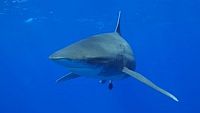 We recently posted about a report by the journal Marine Policy which estimated that around 100 million sharks are being killed each year in the commercial fisheries, a rate far higher than is sustainable for most shark species. On Monday, delegates to the Convention on the International Trade in Endangered Species (CITES) meeting in Bangkok voted to provide addition protection for five threatened species of sharks – oceanic whitetip sharks, porbeagle sharks, scalloped hammerheads, great hammerheads and smooth hammerheads. They also voted protection for two species of manta rays. The votes must still be confirmed in a plenary session later this week. The actions will not ban shark and ray fishing but will regulate the number of fish caught.
We recently posted about a report by the journal Marine Policy which estimated that around 100 million sharks are being killed each year in the commercial fisheries, a rate far higher than is sustainable for most shark species. On Monday, delegates to the Convention on the International Trade in Endangered Species (CITES) meeting in Bangkok voted to provide addition protection for five threatened species of sharks – oceanic whitetip sharks, porbeagle sharks, scalloped hammerheads, great hammerheads and smooth hammerheads. They also voted protection for two species of manta rays. The votes must still be confirmed in a plenary session later this week. The actions will not ban shark and ray fishing but will regulate the number of fish caught.
International Shark Trade to Be Regulated
If the proposals are upheld …, all seven animals will be listed under Appendix II of the CITES Treaty, which includes species that may become threatened with extinction if they are traded unsustainably. So far, basking sharks and great white sharks are the only species of elasmobranch (a family that includes sharks, rays and skates) listed on Appendix II.
Sharks are apex predators that help balance ecosystems in the world’s oceans, and they have slow growth and reproductive rates, making it difficult for their populations to bounce back from big losses. The votes at CITES were applauded by conservationists and biologists who say overfishing is by far the biggest pressure faced by sharks. [On the Brink: A Gallery of Wild Sharks]
The fish are harvested for their meat, liver oil and cartilage, as well as their fins, which are cut off to be used in shark fin soup, an ancient and prized delicacy in East Asia. According to the World Wildlife Fund, a shark’s fin can sell for up to $135/kg in Hong Kong.
Thanks to Alaric Bond for passing on the news.
